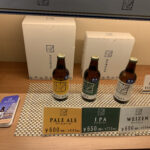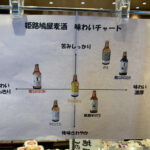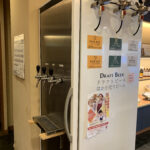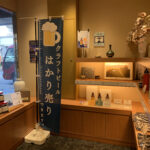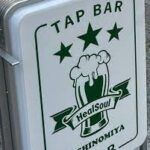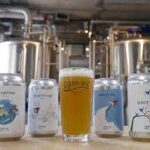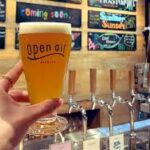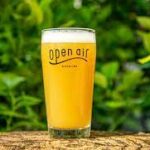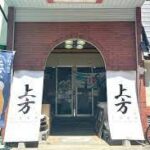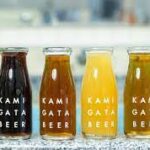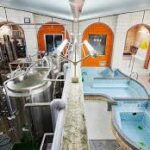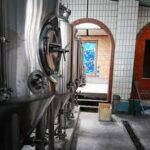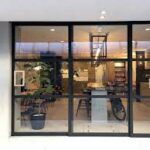Group 4 (Minori, Misaki, Sakurako, Souichiro, Ryouma) – Himeji Hatoya Brewing (Himeji)
株式会社ハトヤは海の幸山の幸に恵まれた姫路に1946年に誕生した。もとはかまぼこ専門店として姫路の味を守り発展させていた会社だった。鳩屋は戦後の復興間もなく開業し、昔ながらの製法で魚の持ち味を生かした西方のかまぼこ屋だった。鳩屋の創業者松本辰二郎は料理人で自分の才や地の利を生かして人々に何か食べてもらえるものは無いかと考え、魚を使用したかまぼこの製造を開始し、平和のシンボルである鳩の名前を使用し鳩屋と名付けた。このかまぼこ屋はイカやタコなどの海鮮類は勿論、播州赤穂産の牡蠣をすり身として練りこんだ播州ならではの商品も存在している。現在の社長は松本敏郎で、現在も鳩屋でかまぼこを売っている。そして2022年に麦酒の醸造を開始した。現在は姫路駅周辺にある本店、三陽店、ピオレ店、姫路鳩屋麦酒グランフェスタ店の四店舗でビールを販売している。姫路鳩屋麦酒グランフェスタ店は2023年にオープンしておりビールを立ち飲みが可能である。ビールの製造を担当しているのは西川聡一郎である。
株式会社ハトヤは第二次世界大戦前、現社長松本敏郎の祖父が飲食店として始めたが、現社長松本氏が事業を継承するにあたり、新事業を始めたいという思いから2022年よりビールの醸造を開始した。もともと蒲鉾を製造していたため、既存の技術や設備を活かしてスムーズに醸造をスタートできた。また、工場は広い土地を確保するためもともとは郊外だった土地に設けられたが、都市開発が進んだ結果、現在の駅近の立地となった。
ハトヤは創業77年を迎えた老舗蒲鉾製造会社で、伝統的な味の蒲鉾は地元の人々に長く愛されている。しかし三代目社長の松本氏は練り物1本での戦い方に限界を感じ、新しい事業に挑戦することに試みた。蒲鉾などの練り物製品は冬場に売り上げが伸び、夏場にはどうしても売り上げが落ちてしまうため、夏場に売り上げを伸ばすことのできる商品かつ既存の蒲鉾と相乗効果が狙える商品を考えた結果、ビールの醸造に行きついた。蒲鉾の製造会社である株式会社ハトヤがビールの醸造を始めたという珍しさから、食品製造の業界でも、ビール醸造の業界でもハトヤの存在感が大きくなり、注目を集めた。また、その話題性と姫路ならではの商品開発で姫路の町おこしにも貢献している。しかし、醸造を開始するにあたり、困難もいくつかあったという。まず、ハトヤはもともとビールを醸造するために立ち上げた会社ではないためビールに関する有識者が社内におらず、ノウハウの導入に苦労した。また酒造には免許が必要であるため免許取得へのハードル、設備投資等の財務面での苦労もあったという。一方で、蒲鉾製造との二毛作的事業形態がもたらすアドバンテージも多くあったという。工場がもともと食品の製造のための作りであったため、衛生的にも問題なく効率良く醸造を進めることができた。また、ゼロからビールの醸造を始めた市内の他の醸造所と違い、蒲鉾産業で獲得した顧客が既に存在したため、売り込みや宣伝がしやすいのも強みであった。さらにその珍しさと話題性からマスコミの注目も集め、複数の取材を受けるなどプロモーションの面で圧倒的に有利だったという。
株式会社ハトヤは長年蒲鉾製造会社として地元で愛されていたこともあり、姫路城に近い大手前公園で開催された姫路食博や、姫路駅中央地下通路で開催されたクラフトビアビュッフェイベントなど地域に根ざした活動に積極的に参加しており、まさに地域密着型企業であると言える。姫路市では現在ハトヤ、イーグレ、フリースピリッツ、コガネヤの4社でクラフトビールの醸造が行われており、それら4社が連携して姫路クラフトビール協会を運営している。4月に神戸で行われるクラフトビールのフェスに姫路クラフトビール協会の4社で出店予定である。さらに、地元姫路を盛り上げるべく、4社で同じレシピでクラフトビールを醸造し、訪れた人々に飲み比べを楽しんでもらうイベントを企画中であり、2024年3月頭に姫路市内で開催予定である。
ハトヤのメインビールは6種類ある。Pale ale は柑橘系のフレーバーが後味に感じられる、定番エールである。IPAは厳選した5種類のホップによるフレーバーを楽しめる。Weizenはバナナの甘い香りが特徴的。姫SAISONは辛口でスパイシーな味を感じられる。殿GINGERは姫路名物の姫路おでんに欠かせない生姜醤油をイメージしたインディアン・ペールエールである。姫路WHITEは白鷺城とも呼ばれる、白く美しい姫路城をイメージしたホワイトビール。人気のビールを聞いてみるとPale ale、 姫路whiteが人気である。松本氏のお気に入りビールはPale aleで、娘さんはweisenが好きだそう。アルコール度数も高すぎず飲みやすいことから学生にはweisenをぜひ試して欲しいとのこと。
本来の技術と伝統を活かし、現在ハトヤでは蒲鉾とビールをセットにした商品も販売している。しかし、実際にはセット商品はあまり売り上げが伸びておらず、蒲鉾とビールそれぞれ別々での購入が多いという。松本氏は、蒲鉾とビールをセットで購入してもらい、双方の良さを多くの人に知ってもらうことが今後の課題であると話す。また、クラフトビールの醸造開始当初は20代~30代の女性をターゲットにしていたが、実際はもう少し年齢層が高めの男性に売れているという。これは元々蒲鉾で有名な会社であるため、長きに渡る常連客がビールを購入していることからこの傾向になっていると考えられている。
ハトヤはクラフトビールを生産するにあたって、経営理念にもある通り、常に新しいことに挑戦すること、顧客のニーズに応えた商品を開発することを重要視している。伝統ある蒲鉾産業からクラフトビールの醸造に踏み切ったように、新しいアイデアで常に顧客を喜ばせたいと、松本氏は語る。
一方で、全く新しい産業に挑戦したことによる苦労もあったという。Pale ale の生産プロセスにおいては、ノウハウもない状態での挑戦であったため、多くの新しい課題にぶつかり、試行錯誤を重ねたという。しかし、地元姫路を盛り上げたいという思いから、殿や姫、姫路城など歴史ある都市である姫路ならではの要素を詰め込んだユニークな商品を生産した。姫路おでんなどの郷土料理から着想を得るなど、オリジナリティ溢れるクラフトビールはまさに姫路市を象徴していると言って良いだろう。
現在ハトヤでは、ドロボーねこぱんちや黒ねこIPAなど猫がモチーフとなった特徴的なパッケージが印象的な商品が期間限定で展開されている。このシリーズは現在の社長松本氏がクラフトビールの修行を積んだ浅草のvector brewingの代表商品「猫パンチ」のパロディ的商品である。クラフトビール醸造業界では、このように修行先の商品を同じ製法でリリースして独立や成長を表す文化が存在するため、松本氏もまた自身の会社の成功への願いと修行先へのリスペクトを込めてドロボーねこぱんちシリーズをリリースした。阪神タイガースが優勝した際にはトラねこをモチーフにした商品も販売され、今後も様々なイベント商品が販売されるだろう。
また、ハトヤは自社製品の開発に加え、姫路商工会議所の創立30周年を記念して特注のクラフトビールを製造した。このような特別なオリジナルのクラフトビールの製造・販売は、自治会やクラブチーム等小規模の団体からの依頼も受けており、依頼主との話し合いから得たイメージをもとにビールをつくり、コンセプトやシーン、ニーズ等を細かく話し合い、企画書を作成する。ハトヤと依頼主双方の合意から早くて2、3ヶ月で商品化できるため、商工会議所の創立30周年のように周年などのイベントを祝うためにも活用可能である。小さなタンク1つで瓶を700本ほど生産可能で、売り残らない量や会場のキャパシティ等を考慮して生産されるという。
松本氏は、ハトヤの更なる発展のため新商品開発へも積極的である。ユニークでストーリーを持たせやすい猫シリーズの新商品はもちろん、ワインのように寝かせるのが特徴のバーレーワインなど、年代による付加価値が特徴となる商品の開発にも挑戦してみたいと彼は語る。また、自社の課題であるセット売りや新規顧客獲得、若い世代や女性へのアプローチを狙った入門用のクラフトビールの開発も視野に入れている。加えて日本酒とのコラボや、ワインと同じ原材料ブドウを使用することによる農家との繋がりの強化、さらには自社のトレードマークである蒲鉾を使ったクラフトビールの醸造など、彼の次の目標は尽きない。様々な角度から提案を続けるオリジナリティ溢れるハトヤのクラフトビール醸造は、これからもさらに成長を続けるだろう。
Hatoya Co., Ltd. was founded in 1946 in Himeji, a city with a rich harvest from the sea and mountains. The company was originally a fish cake specialty store that preserved and developed the taste of Himeji. Hatoya opened soon after the postwar reconstruction, operating as a fish cake shop in the western part of the city, using the traditional method to bring out the best of the fish’s natural flavor. Tatsujiro Matsumoto, the founder of Hatoya, was a chef who wanted to find something for people to eat using his talent and local advantage. The kamaboko shop offers not only seafood such as squid and octopus, but also products unique from Banshu, such as oysters kneaded into the fish paste. The current CEO is Toshiro Matsumoto, who still sells fish cakes at Hatoya. And in 2022, he started brewing beer. Currently, the beer is available at four stores in the Himeji Station area: the main store, the Sanyo store, the Piore store, and the Himeji Hatoya Mugishu Grand Festa store. The Himeji Hatoya Beer Grand Festa Store will open in 2023, and beer can be enjoyed in the store. Soichiro Nishikawa is in charge of beer production.
Hatoya Corporation was started as a restaurant by the grandfather of current president Toshiro Matsumoto before World War II, but when current president Matsumoto took over the business, he wanted to start a new business and began brewing beer in 2022. Since the company had originally manufactured kamaboko, it was able to start brewing smoothly, taking advantage of existing technology and equipment. In addition, the factory was originally located in the suburbs to secure a large plot of land, but as a result of urban development, it is now located near the current train station.
Hatoya is a long-established kamaboko manufacturer that has been in business for 77 years, and its traditionally flavored kamaboko is loved by the local people for a long time. However, Mr. Matsumoto, the third president of the company, felt the limits of competing with only kamaboko, and decided to try a new business challenge. Sales of fish paste products such as kamaboko increase in the winter months and inevitably decline in the summer months. The unusual fact that Hatoya Corporation, a kamaboko manufacturer, started brewing beer made Hatoya’s presence in the food manufacturing industry and in the beer brewing industry significant and attracted a lot of attention. It has also contributed to the revitalization of the town of Himeji through its hot topic and the development of products unique to Himeji. However, there were some difficulties in starting brewing. First, Hattoya was not originally established to brew beer, so there were no beer experts in the company, and it was difficult to introduce know-how. In addition, since a license is required for brewing alcohol, there were financial difficulties in obtaining the license and in investing in equipment. On the other hand, there were many advantages to the duo of producing kamaboko and producing sake. Since the factory was originally built for the production of food products, the brewing process could proceed efficiently and without sanitary problems. Another advantage was that, unlike other breweries in the city that started brewing beer from zero, this company already had customers from the kamaboko industry, making it easy to market and advertise the product. Furthermore, the unusualness and hot topic of the beer attracted the attention of the mass media, and the brewery received multiple media interviews, giving it an advantage in terms of promotion.
Hatoya Co., Ltd. has long been a local favorite as a kamaboko manufacturer, and is truly a community-based company, actively participating in community-based activities such as the Himeji Food Expo held in Otemae Park near Himeji Castle and the craft beer buffet event held in the central underground passageway of Himeji Station. The Himeji Craft Beer Association is a group of four companies that brew craft beer in Himeji: Hatoya, Eagle, Free Spirits, and Koganeya, and the four companies plan to participate in a craft beer festival in Kobe in April. In addition, in order to promote Himeji, the four companies are planning an event in which they will brew craft beers using the same recipe and let visitors enjoy comparing the beers.
Hatoya has six main beers: Pale ale is a classic ale with citrus flavors in the aftertaste; IPA offers flavors from five carefully selected hops; Weizen has a sweet banana aroma; Hime SAISON has a dry, spicy taste; and Hime Kurozu has a dry, spicy taste. Hime SAISON has a dry and spicy taste. Tono GINGER is an Indian pale ale inspired by ginger soy sauce, an essential ingredient in Himeji’s famous Himeji Oden. Himeji WHITE is a white beer inspired by the beautiful white Himeji Castle, also known as Shirasagi Castle. When asked about popular beers, Pale Ale and Himeji White were the most popular. Matsumoto’s favorite beer is Pale Ale, and his daughter likes Weisen. He also recommends that students try Weisen because it is easy to drink and the alcohol content is not too high.
Utilizing the original technique and tradition, Hatoya now sells a set of kamaboko and beer. However, in reality, sales of the set products have not increased much, and many customers purchase kamaboko and beer separately. Mr. Matsumoto says that the future challenge is to get more people to buy kamaboko and beer as a set and to let them know the advantages of both. In addition, when they first started brewing craft beer, they targeted women in their 20s and 30s, but in reality, the beer is selling well to men in a slightly older age group. This trend is believed to be due to the fact that the company is originally famous for its kamaboko, and long-time regular customers purchase the beer.
In producing craft beer, as mentioned in its management philosophy, Hatoya places importance on always trying new things and developing products that meet the needs of its customers. Matsumoto says that they always want to please their customers with new ideas, just as they have done with the traditional kamaboko industry and now with craft beer brewing.
On the other hand, he says, there have been difficulties in taking on the challenge of a completely new industry: “In the production process of Pale ale, we had no know-how, so we ran into many new challenges and went through a lot of trial and error,” he says. However, with the desire to make their hometown Himeji more exciting, they produced a unique product filled with elements characteristic of Himeji, a city with a long history, such as Tono, Hime, and Himeji Castle. Inspired by local food such as Himeji Oden, this craft beer full of originality is a true symbol of Himeji City.
Hattoya is currently offering for a limited time a series of products with impressive packaging featuring cats in distinctive motifs, such as Dorobo Nekopanchi and Black Cat IPA. This series of products is a parody of Neko Punch, the flagship product of vector brewing in Asakusa, where the current president Matsumoto trained in craft beer. In the craft beer brewing industry, there is a culture of releasing products made by the same brewery where one trained to express independence and growth, so Mr. Matsumoto released the Dorobo Nekopanchi series as a sign of respect for his training and a wish for the success of his own company. When the Hanshin Tigers won the championship, products featuring tiger cats were also sold, and various event products will continue to be sold in the future.
In addition to developing its own products, Hatoya also produced a custom-made craft beer to serve as a celebration of the 30th anniversary of the Himeji Chamber of Commerce and Industry. Hattoya also receives requests from smaller organizations, such as neighborhood associations and club teams, to produce and sell these special original craft beers. The company makes the beer based on the image it obtains from discussions with the client, and then creates a proposal after detailed discussion of the concept, scene, needs, and other details. The beer can be commercialized in a few months at the earliest after agreement between Hattoya and the client, so it can be used to celebrate events such as the 30th anniversary of the Chamber of Commerce and Industry. A single small tank can produce about 700 bottles, and the production is based on the amount that will not remain unsold and the capacity of the venue.
Mr. Matsumoto is also actively developing new products for the further growth of Hatoya. He would like to try to develop not only new products in the cat series, which are unique and stories that can be easily told, but also products that feature added value due to their age, such as barley wine, which can be laid down like wine, he says. The company is also looking at developing an entry-level craft beer to address its own issues, such as set sales, attracting new customers, and targeting the younger generation and women. In addition, he has endless goals, such as collaborating with sake brewers, strengthening ties with farmers by using the same grapes as those used for wine, and brewing craft beer using his company’s trademark kamaboko. Hattoya’s craft beer brewing, which is full of originality and continues to offer suggestions from a variety of perspectives, will continue to grow even further in the future.



